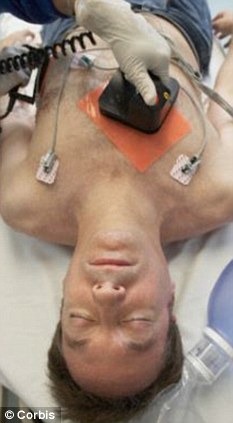
Zapping the brain with magnets could cure cocaine addiction
Anna Hodgekiss
- Changing certain neurons in the brain using magnetic stimulation can wipe away addiction
- Treatment targets the prefrontal cortex - which controls impulses and decision making
- Could be tested immediately in humans
Cocaine addicts could be cured using a technique that stimulates the brain with magnets.
Experiments on mice addicted to cocaine found they were weaned off the drug after laser beams were used to change neurons in a particular part of the brain.
Scientists who report their study in the journal Nature say a similar strategy using magnets could work on human drug abusers - and clinical trials should start soon to see if it works.
They showed by stimulating a region called the pre-frontal cortex with light they could wipe away addictive behaviour in the lab animals - or conversely turn non-addicted rats into compulsive cocaine seekers.

Cocaine addicts could be cured using a technique that stimulates the brain with magnets
Professor Antonello Bonci, who led the study, said: 'When we turn on a laser light in the prelimbic region of the prefrontal cortex the compulsive cocaine seeking is gone.'
He said the study demonstrates the central role the prefrontal cortex - which controls impulses, decision-making and behavioural flexibility - plays in compulsive cocaine addiction.
Prof Bonci, of California University in San Francisco, said it also suggests a new therapy that could be tested immediately in humans.
Any new human therapy would not be based on using lasers but would most likely rely on electromagnetic stimulation outside the scalp - in particular a technique called TMS (transcranial magnetic stimulation).
TMS involves a large electromagnetic coil being placed against the scalp creating an electrical current that stimulates the nerve cells.
An estimated 200,000 people in Britain are addicted to cocaine, and 1.4 million in America.

The drug is a leading cause of heart attacks and strokes for people under 35
The drug is a leading cause of heart attacks and strokes for people under 35.
In the study, the researchers worked with an animal model that mimics compulsive cocaine addiction.
Like human addicts the rats are more likely to make bad decisions and take cocaine even when they are conditioned to expect self-harm associated with it.
Research involving these rats have shown they have extremely low activity in the prefrontal cortex.
Similar studies in humans have shown the same pattern of low activity in this region in people who are compulsively addicted to cocaine.
To test whether altering the activity in this brain region could impact addiction, they employed a technique called optogenetics to shut the activity on and off using a laser.
First, they took light-sensitive proteins called rhodopsins and used genetic engineering to insert them into neurons in the rat's prefrontal cortex.
Activating this region with a laser tuned to the rhodopsins turned the nerve cells on and off.
Turning on these cells wiped out the compulsive behaviour while switching them off turned the non-addicted ones into being addicted.
Follow us: @MailOnline on Twitter | DailyMail on Facebook
